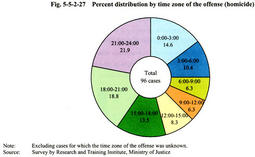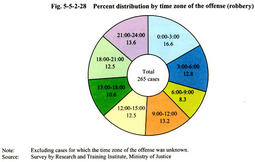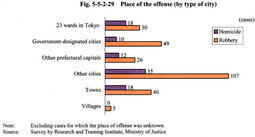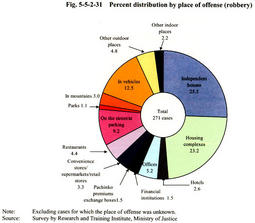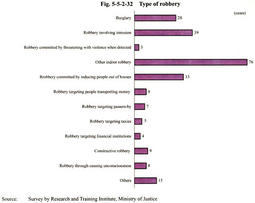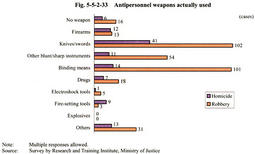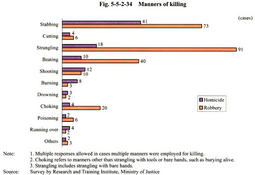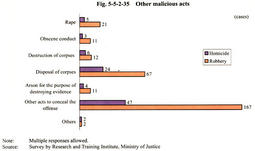| Previous Next Index Image Index Year Selection | |
|
|
3 Analysis on modes of the offense (1) Time zone and place of offense Fig. 5-5-2-27 and Fig. 5-5-2-28 show the time zone of the offense. In the homicide group, 65.6% were committed in the nighttime from 6:00 p.m. to 6:00 a.m. In particular, those committed in the nighttime or late at night from 9:00 p.m. to 3:00 a.m. account for more than 1/3rd, 36.5%, whereas those committed in the daytime (from 6:00 a.m. to 6:00 p.m.) account for a relatively small share. In the robbery group, on the other hand, about half of them, 55.5%, were committed in the 6:00 p.m. to 6:00 a.m. time zone but those committed in the daytime account for almost the same share as those committed in the nighttime or late at night, which is in contrast with the trend in the homicide cases. Considering that, as shown in Chapter 2, about 70% of robbery cases in general were committed in the 6:00 p.m. to 6:00 a.m. time zone it is presumed that the robbery cases targeted in this survey fall under a different category of offense.
Fig. 5-5-2-29 , Fig. 5-5-2-30 , Fig. 5-5-2-31 show the place of offense from various perspectives. By type of city, the number of robbery cases committed in cities other than prefectural capitals is larger than the number of those committed in the 23 wards in Tokyo and government-designated cities, where population is concentrated. This suggests that serious offenses are committed more frequently in cities around metropolitan cities or local cities. By type of place, 52.0% of the homicide cases and 69.4% of the robbery cases were committed indoors. In particular, robbery cases committed in private residences, including independent houses and housing complexes, account for 48.7%. Fig. 5-5-2-32 shows the type of robbery. Many cases were committed indoors, and in particular, the number of cases of "robbery involving intrusion," in which the perpetrators broke into houses before people in the house went to sleep at night, and the number of cases of "other indoor robbery," in which the perpetrators commit robbery while meeting with the victims, are larger than the number of cases of "burglary," in which the perpetrators broke into houses while people in the house were sleeping at night. The number of outdoor robbery cases is small. This is in contrast with the trend of robbery cases in general mentioned in Chapter 2, i.e. the overwhelming majority are street robbery cases, and it may be due to the fact that, as mentioned later, serious offenses are frequently committed against the perpetrators' acquaintances and they are often committed indoors or in closed rooms, because the perpetrators have often planned, from the beginning, to destroy the evidence of the offense by committing homicide, rape, or arson. Fig. 5-5-2-27 Percent distribution by time zone of the offense (homicide) Fig. 5-5-2-28 Percent distribution by time zone of the offense (robbery) Fig. 5-5-2-29 Place of the offense (by type of city) Fig. 5-5-2-30 Percent distribution by place of offense (homicide) Fig. 5-5-2-31 Percent distribution by place of offense (robbery) Fig. 5-5-2-32 Type of robbery (2) Characteristics of modus operandi Fig. 5-5-2-33 , Fig. 5-5-2-34 , Fig. 5-5-2-35 show the type of modus operandi, such as antipersonnel weapons actually used, manners of killing, and other malicious acts. Knives and swords are common weapons both in the homicide and the robbery cases. In the robbery cases, however, binding means such as packing tape and handcuffs are used frequently because robbery perpetrators, for the purpose of taking property, often bind victims to obtain information about where property is stored. In addition to ordinary weapons, drugs (sleep-inducing drugs, tear gas, poison) and stun guns are also used in some cases. Among others, the number of cases in which sleep-inducing drugs and other coma-inducing drugs are used is the same as the number of cases in which firearms are used. More specifically, sleeping drugs or sleep-inducing drugs are used in 9 cases, of which 5 cases are robbery through causing unconsciousness and rape on the occasion of robbery through causing unconsciousness. Such an offense committed with the use of drugs may be one of the types of offenses that will require most caution in the future because, by using drugs, anybody can make any victims unresisting without the use of weapons such as knives, which might leave traces of the offense, and therefore some people might be strongly induced to commit this type of robbery and the perpetrators might be commit it habitually or attempt a perfect crime. It is also notable that stun guns and tear gas, which have conventionally been used as self-defense tools to drive away sexual molesters, are used in some homicide/robbery cases.
According to the results of multiple responses concerning manners of killing, common manners are stabbing or cutting with knives beating with blunt instruments, and strangling with ropes or bear hands whereas the use of drugs is also notable. Common malicious acts other than committing homicide are disposing of corpses and arson for the purpose of destroying the evidence of the offense. Fig. 5-5-2-33 Antipersonnel weapons actually used Fig. 5-5-2-34 Manners of killing Fig. 5-5-2-35 Other malicious acts (3) Misuse of cellular phones As mentioned in Chapter 3 , cellular phone usage has become widespread and they have become one of commodities necessary for daily life, and as might be expected, they are misused for committing offenses. In some of the cases targeted in this survey, cellular phones are used when the perpetrators travel in multiple cars, gather and disperse repeatedly, communicate with each other for conspiracy, and induce victims out of houses. Males who browsed online dating sites suffered extortion or fell victim to badger games and finally got killed on the occasion of robbery. Usability of cellular phones may be a new pitfall in the current society in the current circumstances of crime.
|
